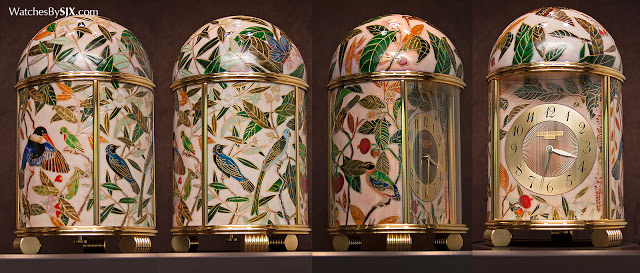Trio of Patek Philippe Dome Clocks Sell for Record Price, Raising S$2.45 million for Charity
Three one of a kind cloisonné enamel Dome Clocks created by Patek Philippe for Singapore's Golden Jubilee have just sold for a total of S$2.45 million, with one going for S$1 million, setting the world record price for its category.
Unveiled just three weeks ago, the Patek Philippe Dome Clocks made for Singapore‘s 50th anniversary, collectively known as SG50, were just sold at a dinner auction overseen by Christie’s on the evening of September 23, 2015. The trio raised a total of S$2.45 million (equivalent to US$1.72 million), with one record price being set with the first clock that went for S$750,00, only to be broken moment later when the last of the clocks sold for S$1 million – to a buyer who immediately donated it to the National Museum of Singapore.
The first clock, Ref. 1677M “The Esplanade – Singapore”, depicting the Singapore skyline on the night of the National Day celebrations, sold for S$750,000. Equivalent to US$527,000, that set the world record price for a Patek Philippe Dome Clock, exceeding the last record of SFr340,000 by a comfortable margin.
The buyer was Anthony Lim, chief executive of Cortina Watch, a major watch retailer based in Singapore. The Esplanade clock will exhibited on a rotating basis at various Patek Philippe boutiques operated by Cortina Watch around South-East Asia.
Estimated at S$300,000, the Esplanade clock was the most complex of the three, with a cloisonné decoration that includes silver foil underneath the fireworks for added sparkle. The money raised will go to the Community Chest, charity that supports social services.
| The dinner auction that was attended by 90 of Patek Philippe’s key clients in Singapore |
Going for S$700,000, the Ref. 1665M “Peranakan Culture” Dome Clock is decorated with a motif from chinaware popular with the Peranakans, descendants of the first Chinese settlers in British Malaya. The sale price will be donated to the Peranakan Museum.
The record set by the first clock did not stand long, with the Ref. 1675M “Farquhar Collection” selling soon after for a cool S$1 million, or about US$702,000. That entire sum will go to the National Museum of Singapore. Estimated at just S$270,000, it is covered with motifs taken from William Farquhar Collection of Natural History Drawings, a compendium of watercolours commissioned by the British Resident of Singapore in 1819 reproducing flora and fauna native to Malaya.
The Farquhar clock was purchased by Dr Henry Tay, Executive Chairman of The Hour Glass, the largest watch retailer in South-East Asia. He has generously given the clock to the National Museum of Singapore, the same institution that owns the Farquhar collection of drawings. You can find more photos of these record breaking Dome Clocks right here.
September 24, 2015: Updated with identity of winner of the Esplanade clock.
Back to top.